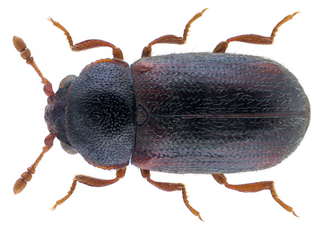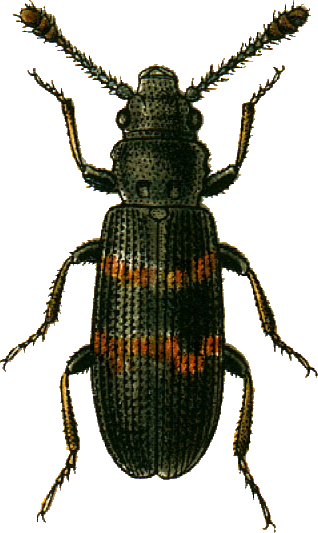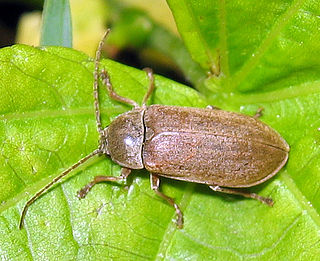
The soldier beetles (Cantharidae) are relatively soft-bodied, straight-sided beetles. They are cosmopolitan in distribution. One of the first described species has a color pattern reminiscent of the red coats of early British soldiers, hence the common name. They are also known commonly as leatherwings because of their soft elytra.

The Elateroidea are a large superfamily of beetles. It contains the familiar click beetles, fireflies, and soldier beetles and their relatives. It consists of about 25,000 species.

Prostomidae is a family of beetles with no vernacular common name, though recent authors have coined the name jugular-horned beetles. They are often found in dead wood. The family consist of two extant genera with about 20 species. Prostomis americanus is known from North America. Other species of Prostomis are found in Europe, Africa, the Pacific region and East Asia. Species of Dryocora are known from New Zealand, Australia and Tasmania.

The Ommatidae are a family of beetles in the suborder Archostemata. The Ommatidae are considered the extant beetle family that has most ancestral characteristics. There are only seven extant species, confined to Australia and South America. However, the geographical distribution was much wider during the Mesozoic spanning across Eurasia and Australia, suggesting that they were widespread on Pangea. So far, over 26 extinct genera containing over 170 species of these beetles have been described. Three extant genera have been assigned to this family: Omma,Tetraphalerus and Beutelius. The family is considered to be a subfamily of Cupedidae by some authors, but have been found to be more closely related to Micromalthidae in molecular phylogenies. A close relationship with Micromalthidae is supported by several morphological characters, including those of the mandibles and male genitalia. Due to their rarity, their ecology is obscure, it is likely that their larvae feed on deadwood.

Sphindidae is a family of beetles, in the suborder Polyphaga. They are called slime mold beetles due to their exclusive feeding on slime molds during adult and larval stages, other aspects of their life history are obscure. Palaeontological discoveries since 2015 have added to the geologic history of Sphindidae, including the discovery of Libanopsis, placed in the extinct subfamily Libanopsinae.

Phloeostichidae is a family of beetles in the superfamily Cucujoidea. They are typically found under the bark of dead trees. Larvae have been found to consume plant tissue and some fungi, while the adults appear to be exclusively fungivores. The family contains four extant genera, Phloeostichus is native to the Palearctic, Rhopalobrachium is native to central-southern South America and eastern Australia, Hymaea is native to southeastern Australia, and Bunyastichus is found in Tasmania.

Smicripidae is a family of beetles, in the superfamily Cucujoidea. The common name for this family is palmetto beetles. The family only has one extant genus, Smicrips, with six extant species native to tropical and subtropical regions of the Americas and extinct species from the Eocene of Europe and one extinct genus, Mesosmicrips, known from the mid Cretaceous aged Burmese amber. Smicrips larvae are usually found amongst decaying vegetation, while adults are typically found on inflorescences, especially those of Arecaceae (palms), although associations with flowers of Fabaceae (legumes), Passifloraceae, Bombacaceae and Cactaceae (cactus) have also been recorded. Their diet is unknown.

The Brachypsectridae are a family of beetles commonly known as the Texas beetles. There are only two extant genera, Brachypsectra and Asiopsectra. Brachypsectra has a cosmopolitan distribution, mostly in arid regions, while Asiopsectra is found in Central Asia and the Middle East.

Eucnemidae, or false click beetles, are a family of elateroid beetles including about 1700 species distributed worldwide.

Clambidae is a family of beetles. They are known commonly as the minute beetles or the fringe-winged beetles. They are found worldwide on every continent except Antarctica.

Burmese amber, also known as Myanmar amber, Burmite or Kachin amber, is amber from the Hukawng Valley in northern Myanmar. The amber is dated to around 100 million years ago, during the latest Albian to earliest Cenomanian ages of the mid-Cretaceous period. The amber is of significant palaeontological interest due to the diversity of flora and fauna contained as inclusions, particularly arthropods including insects and arachnids but also birds, lizards, snakes, frogs and fragmentary dinosaur remains. The amber has been known and commercially exploited since the first century AD, and has been known to science since the mid-nineteenth century. Research on the deposit has attracted controversy due to its alleged role in funding internal conflict in Myanmar and hazardous working conditions in the mines where it is collected.

Dascillidae is a family of beetles within the clade Elateriformia. There are about 100 extant species in 11 genera, which are found worldwide. Dascillidae together with Rhipiceridae form the super family Dascilloidea.
2019 in paleoentomology is a list of new fossil insect taxa that were described during the year 2019, as well as other significant discoveries and events related to paleoentomology that were scheduled to occur during the year.
2020 in paleoentomology is a list of new fossil insect taxa that were described during the year 2020, as well as other significant discoveries and events related to paleoentomology that were scheduled to occur during the year.
Echinocups is an extinct genus of ommatid beetle. It was created in 2020 to house three species originally assigned to Notocupes, E. denticollis, E. neli and E. ohmkuhnlei The genus name refers to the sharp spikes present on the elytra. All three species are known from the Cenomanian aged Burmese amber of Myanmar. The status of Echinocups as a distinct genus was contested by Li et al. (2023), who considered the genus Echinocups to be a junior synonym of the genus Notocupes.
Burmese amber is fossil resin dating to the early Late Cretaceous Cenomanian age recovered from deposits in the Hukawng Valley of northern Myanmar. It is known for being one of the most diverse Cretaceous age amber paleobiotas, containing rich arthropod fossils, along with uncommon vertebrate fossils and even rare marine inclusions. A mostly complete list of all taxa described up until 2018 can be found in Ross 2018; its supplement Ross 2019b covers most of 2019.
This paleoentomology list records new fossil insect taxa that were to be described during the year 2021, as well as notes other significant paleoentomology discoveries and events which occurred during that year.
This paleoentomology list records new fossil insect taxa that are to be described during the year 2022, as well as notes other significant paleoentomology discoveries and events which occurred during that year.

Panguidae is an extinct family of aculeate wasps. It has two unambiguous members, Protopangu known from the Early Cretaceous amber from the Wessex Formation of southern England and Pangu from the mid-Cretaceous Burmese amber of Myanmar. The genus Prosphex, originally considered incertae sedis, was suggested to be a member of the family in a later publication. Their relationships with other aculates are uncertain, and they are considered to be the only members of the superfamily Panguoidea. A specimen of Prosphex was observed with a substantial amount of angiosperm pollen near and within its mouth, implying that it was pollenivorous, and acted as a pollinator for flowering plants. However, other later publications have placed Prosphex outside of Panguidae.
This list of 2023 in paleoentomology records new fossil insect taxa that are to be described during the year, as well as documents significant paleoentomology discoveries and events which occurred during that year.














